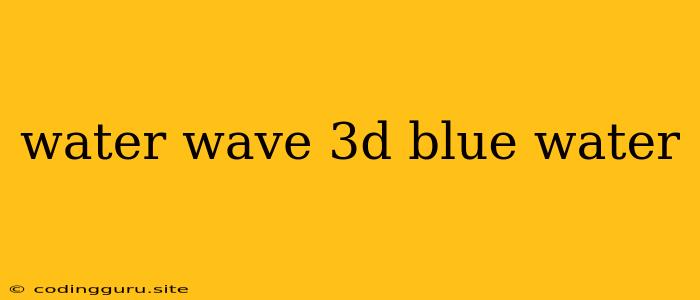Dive into the Depths of 3D Water Waves: Creating Realistic Blue Water Effects
The allure of water has captivated artists and developers alike. Whether it's the calming ebb and flow of the ocean or the invigorating rush of a waterfall, water is a captivating subject. In the realm of 3D graphics, accurately portraying the dynamic nature of water is a challenge that continues to be explored and refined. Creating realistic water waves in 3D, particularly the mesmerizing shade of blue water, adds depth and realism to any virtual environment.
Why is it Important to Master the Art of Water Waves?
Imagine a virtual world where the ocean remains stagnant or a waterfall stands still. This lack of movement would instantly break the illusion of realism. The beauty of water waves lies in their dynamic nature, constantly shifting and interacting with their surroundings. Mastering the art of water waves elevates your 3D creations, adding a layer of realism that enhances the overall visual appeal.
The Challenge of Creating Realistic Water Waves
Water waves are complex phenomena. Their movement is influenced by factors such as wind speed, water depth, and the presence of objects. Replicating this intricate behavior in a 3D environment requires a thorough understanding of the physics involved.
Techniques for Creating 3D Water Waves
-
Procedural Generation: This technique leverages algorithms to generate water waves in real-time. By manipulating parameters like wave amplitude, frequency, and direction, you can create a variety of water wave patterns.
-
Vertex Displacement: This method involves manipulating the vertices of a mesh to simulate the movement of water waves. By applying a displacement map to the mesh, you can create realistic ripples and undulations.
-
Simulation Techniques: More sophisticated approaches involve simulating the actual physics of water waves using techniques like fluid simulation. This allows for highly realistic and dynamic water waves, but it comes with increased computational costs.
Achieving the Perfect Shade of Blue Water
The color of water is not static. It shifts depending on the depth, the time of day, and the presence of impurities. To achieve the desired shade of blue water, consider these tips:
-
Understanding the Light: The color of water is greatly influenced by how light interacts with it. In shallow areas, the color tends to be lighter and more greenish, while deeper water appears darker and more blue.
-
Using Color Gradients: Create a subtle gradient from lighter blues near the surface to darker blues at the bottom. This adds depth and realism to the water.
-
Adding Subsurface Scattering: Implement subsurface scattering to simulate the way light interacts with water molecules. This creates a more natural and vibrant look for the blue water.
Examples of 3D Water Waves in Action
From video games to architectural visualizations, 3D water waves are used to enhance the realism and visual appeal of countless virtual worlds.
-
Video Games: Popular video games such as "The Legend of Zelda: Breath of the Wild" and "Horizon Zero Dawn" feature impressive water wave effects that enhance the immersive gameplay experience.
-
Architectural Visualization: Architects use 3D water waves to create compelling visualizations of waterfront properties and landscapes.
-
Film and Animation: Water wave effects are crucial for creating realistic underwater scenes in films and animated movies.
Conclusion
Mastering the art of water waves is a rewarding journey for any 3D artist. By combining the right techniques and understanding the principles behind water wave behavior, you can create stunning and realistic water waves that add depth and life to your virtual worlds. Whether you're striving for a calm and serene ocean or a turbulent and dramatic waterfall, remember the key to achieving realism lies in paying attention to the nuances of light, color, and movement.
